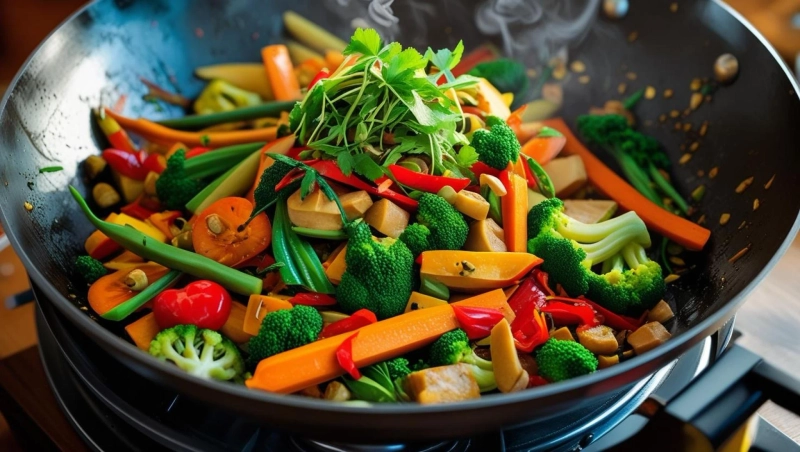The first thing you think of when you hear cooking without oil is a look of suspicion: “How do you even cook Indian food without oil?” From tadkas to deep-frying, oil is ingrained in Indian cuisine and not just for taste, but for tradition. But as heart disease, diabetes, obesity, and fatty liver become endemic in younger Indians, the questions are piling up: “Can oil-free cooking be done, and if so, is this even healthy, feasible, and good for my family?”
In this article, we’re not just suggesting recipes. We are providing a real-life, doctor-backed roadmap to knowing zero-oil cooking, and how to make it work in the kitchens of everyday Indian households without sacrificing flavor, texture, or joy.
Why Zero Oil Cooking? A Doctor’s Perspective
Let’s start with the facts.
Each spoonful of oil — be it mustard, sunflower, ghee, or olive — has 120 full-blown calories of fat and zero fiber. Now, there are healthier fats out there, but the refined oils (that most Indian homes use) have been directly associated with the following:
- Increased LDL (bad) cholesterol
- Inflammation
- Insulin resistance
- Heart attacks and strokes
According to Dr. Bimal Chhajer, a prominent Indian heart and lifestyle expert and the founder of SAAOL, “Oil is no more a nutrient, it’s a processed extract. Your body doesn’t need it. Your food is still delicious without it.” This shift has given a quiet revolution voice: Zero oil cooking is no longer a passing trend. It is becoming a treatment option, prescribed for patients with high BP, diabetes, fatty liver, or high cholesterol.
What Is Zero Oil Cooking?
Zero oil cooking is simply cooking without adding any cooking oil, ghee, butter, margarine, or shortening.
But here’s what it’s not:
- It’s not boiled or bland food
- It does not mean consuming raw salads forever
- And it’s definitely not exclusively for sick people, either.
It’s not, instead it’s a clever way of preserving the taste of the olden times with things such as:
- Steaming
- Dry roasting
- Grilling
- Pressure cooking
- Water sautéing
With natural fats (every ingredient has its natural fat)
How to Cook Indian Food Without Oil (Without Compromising on Taste)
Step 1: Master the Art of Dry Sautéing
Instead of heating oil, start by roasting spices and onions in a hot non-stick or iron kadhai. Use a splash of water or tomato puree if it starts to stick. You’ll be surprised how beautifully the aroma releases—even without oil.
Step 2: Use Moisture-Rich Ingredients
Tomatoes, curd (low-fat), bottle gourd, spinach, and pumpkin—they naturally carry water and richness. This helps build gravy-based curries without needing oil.
Step 3: Build Flavour in Layers
Add ginger-garlic paste, green chilies, black salt, roasted jeera powder, and herbs in sequence, allowing each to cook down. This gives the food depth, without needing that oily glaze.
Step 4: Finish with Texture
Use: Crushed methi or curry leaves. Dry-roasted besan. Lemon juice or amchur. These finishing touches bring back crunch and tang, often associated with oil-based food.
Zero Oil Indian Dishes You Can Cook Today
Here are everyday recipes that are all oil-free, yet flavourful:
- Zero Oil Chole (Cooked with roasted masala, tomato base, no tadka)
- Oil-Free Baingan Bharta (Smoked brinjal, burnt garlic, dry spices)
- Zero Oil Kadhi (Tempered with sour curd, roasted besan, curry leaves)
- Oats Dhokla or Upma (Steamed, with dry-roasted mustard seeds)
- Stuffed Paratha Without Oil (Cooked on an iron tawa, brushed with a little water)
- Oil-Free Rajma (Pressure-cooked, slow-simmered with spices)
- Zero Oil Daliya Khichdi (Vegetable-laden, pressure-cooked, tangy with a twist of lemon)
And that even traditional festive foods like paneer tikka, bhindi masala, and kachaalu chaat can be made 100% oil-free when applied zero-oil cooking smartly.
Zero Oil Diet Benefits for Heart, Liver, and Weight Loss
Heart Health Improvement
- Numerous Indian cardiologists refer to zero oil diets for:
- Reducing cholesterol (LDL)
- Reducing the risk of re-blockages after stents or bypass
- Increasing the Ejection Fraction in the weak-hearted patients
Fatty Liver Reversal
A common problem in urban India, fatty liver is typically caused by too much fat in the diet, not alcohol. zero-oil cooking equals less liver load and less inflammation.
Type-2 Diabetes Control
Oil slows digestion, increases insulin resistance, and adds hidden calories. Removing oil helps stabilize blood sugar levels.
Natural Weight Loss
Many patients on zero-oil diets report 2–5 kg of loss per month without additional exercise through zero-oil cooking alone.
Is zero-oil cooking Expensive and Complicated?
Short answer: No. It saves money.
Here’s how:
- It saves you oil purchase of ₹500–₹1000/month
- Fewer medicines needed over time
- Fewer complications mean fewer hospital trips
Also, it’s not a fad diet. It is a return to Indian roots — to a time when food was steamed and roasted and boiled, before oil-heavy commercial cooking moved in.
Who Should Go For Zero Oil Cooking?
You should not wait for a diagnosis to eat healthier.
Zero oil cooking is especially useful for:
- Heart patients (blockages, angina, low EF)
- Diabetics and pre-diabetics
- Patients with fatty liver, PCOS, or thyroid
- Children to prevent early obesity
- Anyone looking to lose weight naturally
It’s doctor-approved, science-backed, and family-friendly.
Zero Oil Is Not About Missing A Taste, It's All About Adding Life
What zero oil cooking offers is freedom from disease, guilt, and heaviness. Not sacrificing taste — improving your health. It’s not a loss of indulgence; it’s a gain of energy. And after tasting your first light, oil-free chole bhature that tastes and feels like home, you’ll never look back. Zero oil cooking isn’t extreme. It’s evolution. And it is the health shift millions of Indians never knew they needed.


